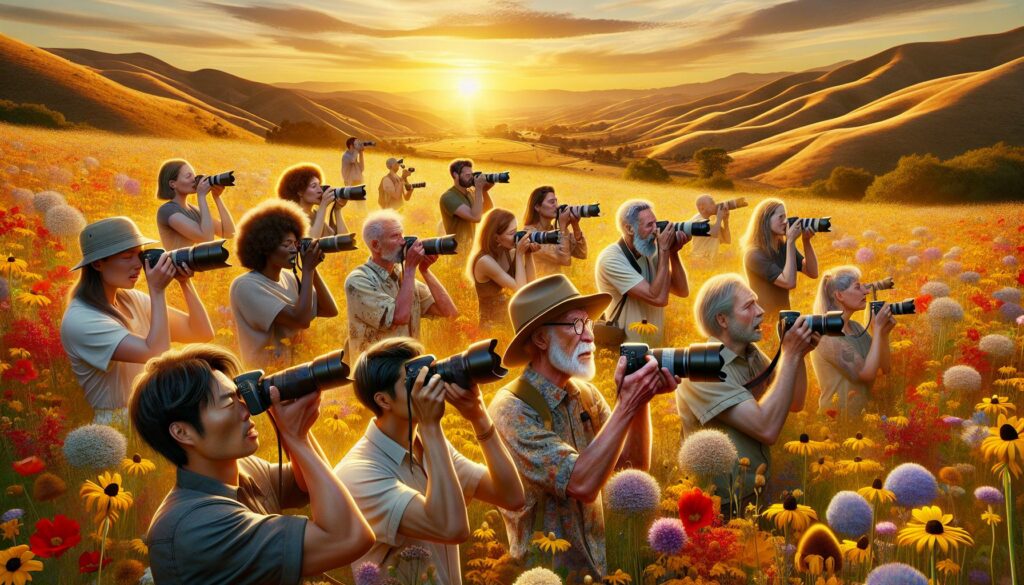Have you ever stumbled upon a photo so captivating that it takes your breath away? I’ve spent years exploring the art of photography and I’m constantly amazed by how a single image can tell a powerful story or evoke deep emotions.
In my experience as a photographer I’ve learned that true beauty in photography goes far beyond technical perfection. It’s about capturing those fleeting moments that speak to the soul – whether it’s the golden light of sunset dancing across a landscape or the genuine smile of a child at play. Through this article I’ll share my insights on what makes a photo truly beautiful and how you can create stunning images that resonate with viewers.
Key Takeaways
- The key elements of beautiful photography include composition techniques like the Rule of Thirds, leading lines, and strategic placement of subjects within the frame
- Light is fundamental in photography – understanding both natural light (especially during golden hour) and artificial lighting helps create stunning images
- Camera settings like aperture (for depth of field control) and shutter speed (for motion capture) are crucial technical aspects that affect image quality
- Professional post-processing techniques like color grading, tone adjustment, and selective sharpening can enhance photos while maintaining natural authenticity
- Common mistakes to avoid include improper camera handling, poor composition choices, incorrect exposure settings, and over-processing in post-production
- Using appropriate equipment, maintaining gear, and mastering technical skills are essential for consistently creating beautiful photographs
Beautiful:W0havxbcug8= Photo
Photo composition transforms ordinary scenes into compelling visual stories through strategic placement of elements.
Rule of Thirds in Photography
The rule of thirds divides an image into nine equal segments using two horizontal and two vertical lines. I position key elements along these lines or at their intersecting points to create balanced compositions. Here’s how I apply this principle:
- Place horizons along the top or bottom horizontal line
- Position main subjects at intersection points for visual impact
- Align vertical elements like trees or buildings with vertical lines
- Frame portrait subjects’ eyes along the top horizontal line
Leading Lines and Visual Flow
Leading lines guide viewers’ eyes through an image in a deliberate path. I incorporate these directional elements:
- Curved roads winding through landscapes
- Railway tracks converging toward the horizon
- Architectural elements like staircases or hallways
- Natural patterns in rivers streams or mountain ridges
- Position lines starting from image corners
- Direct lines toward the main subject
- Use multiple converging lines to create depth
- Incorporate S-curves for dynamic movement
| Line Type | Visual Impact | Common Examples |
|---|---|---|
| Straight | Direct, bold | Roads, buildings |
| Curved | Graceful, natural | Rivers, paths |
| Diagonal | Dynamic, energetic | Bridges, fences |
| Converging | Creates depth | Railroad tracks |
Mastering Light and Exposure
Light forms the foundation of photography, shaping how subjects appear and emotions convey in images. I’ve learned that understanding light’s behavior creates opportunities for capturing stunning photographs in any situation.
Natural vs Artificial Lighting
Natural lighting provides dynamic range through sunlight diffused by clouds clouds atmospheric conditions. I capture outdoor portraits using open shade from buildings trees during harsh midday sun. Indoor environments benefit from window light positioned at 45-degree angles to subjects, creating gentle shadows gradients. Artificial lighting offers precise control through speedlights strobes, enabling consistent results regardless of time conditions. I position key lights at eye level soft boxes create wrap-around illumination while rim lights separate subjects from backgrounds.
Working with Golden Hour
Golden hour occurs during the first hour after sunrise last hour before sunset, bathing scenes in warm directional light. I schedule outdoor shoots 30 minutes before sunset to utilize the soft orange glow diffused shadows. Positioning subjects with back lighting creates rim effects while reflectors bounce light onto faces. The extended shadows during this period add depth dimension to landscapes cityscapes. I expose for highlights maintain detail in darker areas, preserving the rich colors dramatic contrast characteristic of golden hour photography.
Essential Camera Settings for Stunning Images
Camera settings form the foundation of technical excellence in photography, enabling precise control over how light enters the camera and how motion is captured. Here’s how to master the fundamental settings for exceptional results.
Aperture and Depth of Field
The aperture setting controls the amount of background blur and focus depth in an image. I use wider apertures (f/1.4 to f/2.8) for portraits to create smooth, creamy backgrounds that make subjects stand out. Narrower apertures (f/8 to f/16) produce sharp details from foreground to background, ideal for landscape photography. Here’s how different f-stops affect depth of field:
| Aperture | Depth of Field | Best Used For |
|---|---|---|
| f/1.4-2.8 | Very shallow | Portraits, low light |
| f/4-5.6 | Moderate | Street, events |
| f/8-16 | Deep | Landscapes, architecture |
| Subject Motion | Shutter Speed | Effect |
|---|---|---|
| Sports/Wildlife | 1/1000s+ | Sharp freeze |
| Walking people | 1/250s | Clear movement |
| Moving water | 1/15s or slower | Smooth blur |
Post-Processing Techniques
Post-processing transforms raw captures into refined photographs through precise adjustments in professional editing software. I’ve developed specific methods to enhance images while maintaining their natural authenticity.
Color Grading and Tone
Color grading elevates the emotional impact of photographs through controlled adjustments to color temperature, tint, and saturation. I use split-toning techniques to add warm highlights (2700K-3200K) and cool shadows (6500K-7500K) in portraits, creating depth and dimension. Here’s my approach to color adjustments:
- Calibrate white balance using neutral gray points
- Apply HSL adjustments to individual color channels
- Create color harmony through complementary palettes
- Implement selective color grading for skin tones (1-2 stops warmer)
- Use gradient maps for cinematic color effects
- Utilize frequency separation to refine texture (high) and tone (low)
- Add clarity (+15 to +30) to midtones for punch
- Implement selective sharpening on focus points
- Apply dehaze tool (-10 to +15) for atmospheric depth
- Create micro-contrast through targeted luminosity masks
| Adjustment Type | Standard Range | Portrait Range | Landscape Range |
|---|---|---|---|
| Clarity | +15 to +30 | -10 to +10 | +20 to +40 |
| Texture | +10 to +25 | -5 to +15 | +15 to +35 |
| Dehaze | -10 to +15 | -5 to +10 | +5 to +25 |
| Sharpening | 50-70 | 35-50 | 60-80 |
Common Photography Mistakes to Avoid
Camera Handling Issues
- Setting incorrect ISO values that introduce excessive noise (e.g., ISO 6400 in daylight)
- Using autofocus without checking the focus point placement
- Holding the camera improperly with unstable grip points
- Selecting inappropriate shutter speeds for the shooting conditions
Composition Errors
- Placing the horizon line directly in the center of landscapes
- Cutting off limbs in portrait photography
- Including distracting background elements behind subjects
- Positioning main subjects too close to frame edges
Technical Oversights
- Shooting in JPEG instead of RAW for important photographs
- Missing critical focus on eyes in portrait photography
- Forgetting to check histogram displays for exposure accuracy
- Using on-camera flash as primary light source
Lighting Mistakes
- Photographing subjects with harsh overhead sunlight
- Ignoring white balance settings in mixed lighting
- Positioning subjects with light sources behind them
- Using high-powered flash without diffusion
Common Processing Errors
- Over-saturating colors beyond natural appearance
- Applying excessive sharpening that creates halos
- Heavy-handed noise reduction that removes detail
- Inconsistent editing styles across photo series
- Failing to format memory cards regularly
- Not carrying spare batteries for extended shoots
- Using inappropriate lens choices for subjects
- Neglecting to clean sensors and lenses
This structured approach to identifying and addressing common mistakes serves as a practical checklist for photographers aiming to elevate their image quality. Each point represents a specific area where attention to detail makes a significant difference in final results.
| Error Type | Impact Level | Time to Fix |
|---|---|---|
| Wrong ISO | High | Immediate |
| Poor Focus | Critical | Reshoot Required |
| Bad Composition | Medium | Crop/Reshoot |
| Wrong WB | Low | Post-Processing |
| Over-Processing | Medium | 15-30 Minutes |
Creating beautiful photos is a journey that blends technical mastery with artistic vision. I’ve shared my insights on composition lighting camera settings and post-processing techniques that’ll help elevate your photography to new heights.
Remember that truly stunning images come from a deep understanding of these fundamentals combined with your unique creative perspective. With practice and dedication to mastering these elements you’ll develop your signature style and capture photos that resonate with viewers.
I encourage you to step out with your camera and experiment with these techniques. Every photo is an opportunity to grow and develop your artistic voice. The path to creating beautiful photos is ongoing but the rewards of capturing moments that move and inspire others make it all worthwhile.
“

